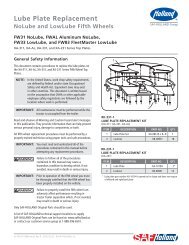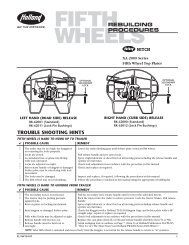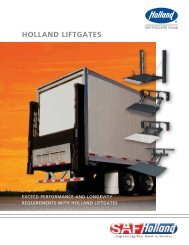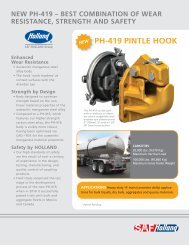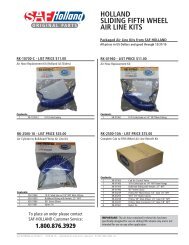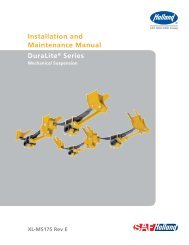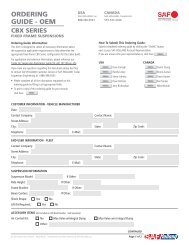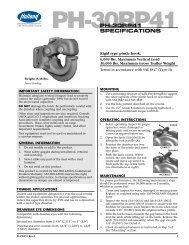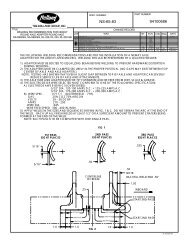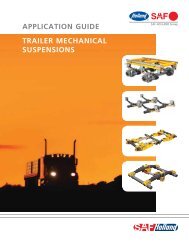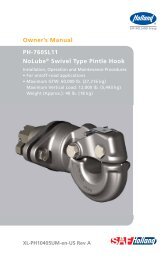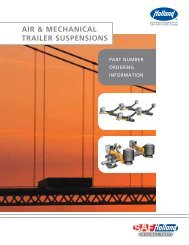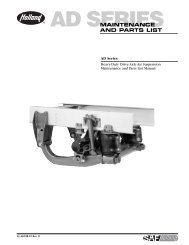XL-PH10397SG - saf-holland
XL-PH10397SG - saf-holland
XL-PH10397SG - saf-holland
You also want an ePaper? Increase the reach of your titles
YUMPU automatically turns print PDFs into web optimized ePapers that Google loves.
Glossary<br />
ASTM<br />
American Society for Testing and Materials<br />
Converter Dolly / Dolly<br />
An auxiliary axle chassis consisting of a frame with single or<br />
tandem axles, suspension, fifth wheel, and tongue with drawbar.<br />
A dolly is used to convert a semi-trailer into a full trailer.<br />
‘A’ Dolly<br />
A converter dolly with a single point of<br />
attachment to the towing vehicle; the<br />
point being located along the centerline “A” DOLLY<br />
of the dolly.<br />
‘C’ Dolly<br />
A converter dolly with two points of attachment to the<br />
towing vehicle; the points being equally spaced along the<br />
centerline of the dolly.<br />
Drawbar<br />
The structural member of the trailer tongue that attaches the<br />
drawbar eye or lunette to the trailer tongue. Drawbars are<br />
typically bolt-on or weld-on and are available as rigid mount or<br />
swivel mount.<br />
Drawbar Eye / Lunette<br />
A round ‘doughnut’ shaped device used to couple a trailer<br />
tongue to a towing vehicle equipped with a coupling device<br />
such as a pintle hook or coupler.<br />
Full Trailer<br />
A trailer equipped with two or more axles that support the<br />
entire weight of the trailer. Full trailers typically feature a hinged<br />
trailer tongue.<br />
Gross Trailer Weight (GTW) / Maximum Gross Trailer<br />
Weight (MGTW)<br />
The actual total weight measured at the ground of a fully<br />
loaded trailer or multiple coupled trailers. Maximum Gross Trailer<br />
Weight is the largest weight of both the trailer(s) and payload<br />
that can <strong>saf</strong>ely be towed by a coupling device.<br />
Off-Road<br />
Refers to terrain on which a tow/towed vehicle will operate<br />
which is ungraded, rough or undulating, with no maintained<br />
travel surface, generally considered to not be part of the public<br />
road system. Examples include agricultural fields, construction<br />
sites, utility right-of-way, temporary logging roads, and what is<br />
commonly refered to as ‘two-track’ roads.<br />
Over-The-Road<br />
Refers to terrain on which a tow/towed vehicle will operate<br />
which is paved or features a graded surface, generally<br />
considered to part of the public road system.<br />
SAE<br />
Society of Automotive Engineers<br />
J429 - Mechanical and material requirements for externally<br />
threaded fasteners<br />
J847 - Trailer towbar eye and pintle hook/coupler<br />
performance<br />
Semi-trailer<br />
A trailer, except pole trailer, so constructed that a substantial<br />
part of its weight rests upon or is carried by another vehicle or<br />
converter dolly.<br />
Tare Weight / Unloaded Vehicle Weight (UVW)<br />
The total weight of a vehicle at the ground, including normal<br />
fluids and equipment, in a condition to receive occupants and<br />
payload.<br />
Trailer Tongue<br />
The structural member of a trailer that connects to a towing<br />
vehicle.<br />
Vertical Load / Maximum Vertical Load<br />
The load or downward force measured at the drawbar located at<br />
the coupling end of the trailer tongue. Maximum Vertical Load is<br />
the manufacturer’s recommended static vertical load (down) that<br />
can be <strong>saf</strong>ely applied to the coupling device.<br />
Gross Vehicle Weight Rating (GVWR)<br />
The value specified by the manufacturer as the loaded maximum<br />
weight of a single motor vehicle or trailer.<br />
Jackknife<br />
Over-articulation between the towing and towed vehicles<br />
(generally greater than 90 degrees) that results in binding at the<br />
coupling connection.<br />
Negative Vertical Load<br />
The load as an upward<br />
force measured at the<br />
drawbar located at<br />
the coupling end of<br />
the trailer tongue. A<br />
negative vertical load<br />
typically results from the<br />
payload being placed<br />
behind the trailer axle<br />
(see illustration).<br />
Negative<br />
Vertical<br />
Load<br />
Positive<br />
Vertical<br />
Load<br />
PAYLOAD<br />
PAYLOAD<br />
<strong>XL</strong>-<strong>PH10397SG</strong>-en-US Rev C 02-2013<br />
Amendments and errors reserved. © SAF-HOLLAND, Inc.<br />
65



